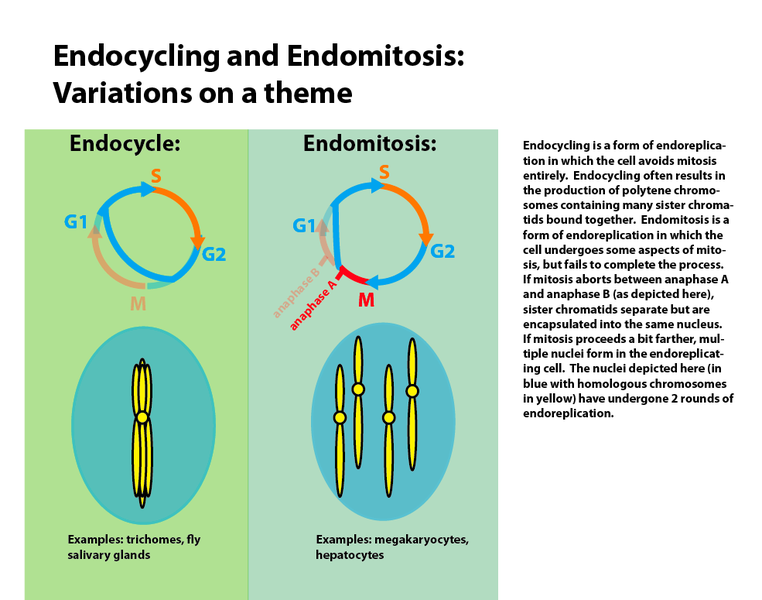
Answer
438.9k+ views
Hint:Endomitosis is a phenomenon that inevitably results in polyploidization. Polyploidization is a state wherein the body cells contain more than two paired numbers of chromosomes. Many of the organisms whose nucleus cells (eukaryotes) are diploid which means that they will have two sets of chromosomes, one set inherited from each parent.
Complete answer:Division of chromosomes in the absence of cell division or nuclear division is referred to as endomitosis that ultimately results in multiple copies within each cell. It exists in particular in the salivary glands of Drosophila as well as other flies. Cells in such tissues include giant chromosomes, each composed of far more than 1,000 closely linked or synapsed chromatids. In conversely to mitosis, the nuclear membrane and nucleolus really aren't ruined, the cleavage spindle was not formed and the cytoplasm is not restructured. However, chromosomes are heading through a cycle of spiraling and despiralization. Prolonged endomitosis has led to the establishment of giant polyploid nuclei, despite an increase in DNA in the cell. The term "endomitosis" also describes the process of repetitive doubling of the nucleoprotein strings, which make up the core of chromosomes, without raising the number of chromosomes. As a consequence of a substantial increase in the amount of DNA in the nucleus, giant chromosomes develop.
So, the correct answer is (B).

Additional Information:
The word endomitosis originally applied to a rare cell division in which mitosis happens without nuclear membrane breakdown or cytokinesis. Currently, however, this concept is much more frequently used to define processes that go through anaphase but skip nuclear division and cytokinesis. In some other variants of the cell cycle, nuclear division occurs despite cytokinesis, ending in multinucleate cells. Such cycles can be seen in mammalian hepatocytes and osteoclasts, and also in molds like Physarum.
Note:In endomitosis, there could be recurrent multiplication of chromatids in geometric progression with no need for cell division. In this cycle, DNA and chromatids continue to proliferate in the form of GP. This enables the chromosome to multi-stranded and expands the DNA content to 1000 or more times. Examples are human liver cells.
Complete answer:Division of chromosomes in the absence of cell division or nuclear division is referred to as endomitosis that ultimately results in multiple copies within each cell. It exists in particular in the salivary glands of Drosophila as well as other flies. Cells in such tissues include giant chromosomes, each composed of far more than 1,000 closely linked or synapsed chromatids. In conversely to mitosis, the nuclear membrane and nucleolus really aren't ruined, the cleavage spindle was not formed and the cytoplasm is not restructured. However, chromosomes are heading through a cycle of spiraling and despiralization. Prolonged endomitosis has led to the establishment of giant polyploid nuclei, despite an increase in DNA in the cell. The term "endomitosis" also describes the process of repetitive doubling of the nucleoprotein strings, which make up the core of chromosomes, without raising the number of chromosomes. As a consequence of a substantial increase in the amount of DNA in the nucleus, giant chromosomes develop.
So, the correct answer is (B).

Additional Information:
The word endomitosis originally applied to a rare cell division in which mitosis happens without nuclear membrane breakdown or cytokinesis. Currently, however, this concept is much more frequently used to define processes that go through anaphase but skip nuclear division and cytokinesis. In some other variants of the cell cycle, nuclear division occurs despite cytokinesis, ending in multinucleate cells. Such cycles can be seen in mammalian hepatocytes and osteoclasts, and also in molds like Physarum.
Note:In endomitosis, there could be recurrent multiplication of chromatids in geometric progression with no need for cell division. In this cycle, DNA and chromatids continue to proliferate in the form of GP. This enables the chromosome to multi-stranded and expands the DNA content to 1000 or more times. Examples are human liver cells.
Recently Updated Pages
Who among the following was the religious guru of class 7 social science CBSE

what is the correct chronological order of the following class 10 social science CBSE

Which of the following was not the actual cause for class 10 social science CBSE

Which of the following statements is not correct A class 10 social science CBSE

Which of the following leaders was not present in the class 10 social science CBSE

Garampani Sanctuary is located at A Diphu Assam B Gangtok class 10 social science CBSE

Trending doubts
A rainbow has circular shape because A The earth is class 11 physics CBSE

Which are the Top 10 Largest Countries of the World?

Fill the blanks with the suitable prepositions 1 The class 9 english CBSE

Which of the following was the capital of the Surasena class 6 social science CBSE

How do you graph the function fx 4x class 9 maths CBSE

The Equation xxx + 2 is Satisfied when x is Equal to Class 10 Maths

Give 10 examples for herbs , shrubs , climbers , creepers

Difference between Prokaryotic cell and Eukaryotic class 11 biology CBSE

Who was the first Director General of the Archaeological class 10 social science CBSE




